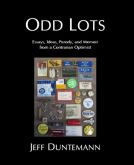Wrapping up the series, which began here.
By far, the most contentious issue in weight loss these days has nothing to do with carbs or fat. It’s about the sheer quantity of the stuff that we eat. In one corner are the people who say that one calorie is exactly like every other calorie, and the only thing you have to do to lose weight is to eat fewer calories. In the other corner are people who say that if you eat the right stuff (typically protein, fat, and green vegetables) you can hork down as much as you want and not gain weight.
Who’s right? We don’t know.
We don’t know a great many things about human health. In my view, the ad lib diet question is the biggest single unknown in the whole weight-loss arena. This may be because both sides assume that they’re right (settled science!) and insist that no further research is necessary. Alas, I’m appalled at how little good research there actually is.
But I have noticed something: Carol and I tend to pick up weight when we travel. Part of this may be the fact that we often go home to Chicago on holidays, when there’s loads of snackable sugar around. But it occurs almost any time we’re away for a week or more. When we get home, the weight vanishes over the next several weeks.
Hmmm. When we’re away, we eat at restaurants a lot. When we’re home, we hardly eat at restaurants at all.
I was boggled to learn that many people eat at “sit-down” restaurants four or five times a week. Carol and I eat at restaurants perhaps two or three times a month. Good stats are hard to come by, but this graph (possibly skewed by the nature of the site and its patrons) says a lot. 25% of the respondents confessed to eating out or doing takeout 6-11 times per week. Not per month. Even cutting that in half in an effort to back out selection bias, we still have a quarter of Americans eating restaurant food 12-22 times per month.
Wow.
Note well that I’m not talking about fast-food here. Fast-food meals are fairly small compared to sit-down restaurant meals, and I think their primary contribution to weight gain is unlimited refills on sugared drinks. Writer Tom Naughton tried to get fat eating at McDonald’s for a month and failed. He published his food logs. Morgan Spurlock of Super Size Me fame did the same thing and claimed all kinds of health problems as a result. Spurlock has steadfastly refused to release his food logs (if he indeed ever kept them at all) and so to me his research is “research” and very likely bogus.
Looking carefully at sit-down restaurant meals reveals two things: The portions are very large, and the meals are carb-heavy. Been to Macaroni Grill lately? Egad. You’re looking at a couple of pounds of pasta. Carol and I have also noticed that restaurant pizza has gotten crustier in recent years. Baked potatoes, which I remember as smaller than my fist decades ago, now seem as large as wing-tip shoes. Carbs are cheap. Wheat in particular is cheap, and there are special issues with wheat, as I explained earlier in the series. There is also the natural tendency to eat the whole thing at the restaurant rather than take two-thirds of it home.
If any experiment is possible relating to portion size, it’s this: Stay out of restaurants for a month and see what happens. If you lose some weight, try to do it for another month and see if the trend continues. If it does, don’t panic. It doesn’t mean you have to stay out of restaurants forever. It may mean that you have to cut back, to perhaps one meal a week or so. Say five a month.
My thought on the portion control issue is that portion size does matter, but because it’s so difficult to separate the portion size issue from the carbs issue in restaurant meals, it’s tough to put real numbers to in any reasonable experiment. Eating out less may simply mean eating carbs less, and that’s almost certainly a win.
They don’t state it explicitly, but having looked at the methods of weight-control programs like Jenny Craig and Weight Watchers, I’d say they work because they’re portion-training systems. No, their pre-packaged meals don’t look all that appetizing. They are, however, modest in size and contain enough energy not to shock your body into fat-storage mode. Eating a little less on a regular basis works better than starving yourself for a couple of months and then giving up. Do that and you will gain weight.
Eating smaller portions at home is easier because you control the portions. One trick I’ve seen is just to use smaller plates, so that less food looks like more. Beyond that, it’s just planning. Don’t cut portions in half when you’re getting started. Ramp down slowly. Don’t stop when you feel full. Stop when you no longer feel hungry.
And that’s pretty much all I had in my notes about weight loss. I’ve lost 20+ pounds since 1997, almost all of it from my gut, which is where you want fat the least. I eat low-carb, which for me is mostly low (or no) sugar. I eat high-fat by conventional standards: Butter? Love it. Meat? Lots! Eggs? Every day. By experiment I’ve determined that modest quantities of wheat, potatoes, and rice don’t seem to have the effect on me that they do on many people.
But that’s been the whole point of this series: You cannot generalize about human metabolism. We’re all over the map. You have to do the science to find out what works for you. So do the science. Keep good records. Don’t starve yourself. Be patient. Believe your findings. (That can be tricky when you’re nostril-deep in diet books that all claim to know The Way.)
It’s a peculiar and surprising business. If you learn anything interesting, do let me know.










